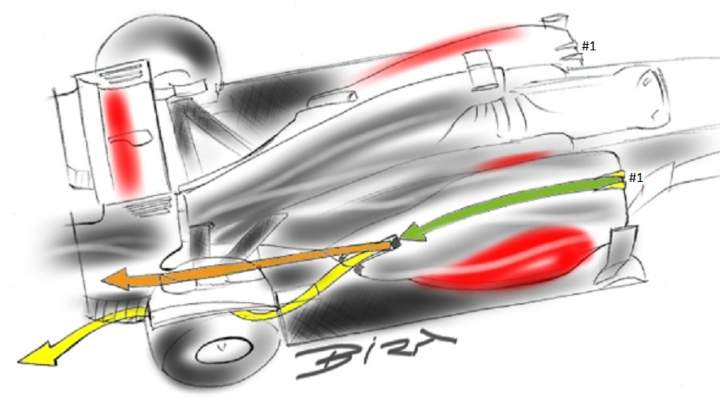A translation from this sports site:
http://tazio.uol.com.br/blog/telemetria/o-eficiente-sistema-de-escape-da-mclaren/In the last GP, some teams had new versions of Exhausts most interestingly based on the model of Mclaren. But what's so special about them?
Mclaren has developed an exhaust very good, as much as those presented by Sauber at the start of the championship, but now I believe that the McLaren is a much more efficient. As I see its theoretical operation:

Just as some other teams, when the Mclaren car is at low speeds, the exhaust blow more toward the small fins located behind the airfoil wheels by the rear brake ducts (orange arrow). This creates a large gain in downforce over the rear wheels directly, and consequently more grip and traction tire.
But at high speeds, the cooler and denser air passing over the sidepods (green arrow) pushes the exhaust gases of the jet down (yellow arrow), causing the long ago effect (coanda). This allows the exhaust to blow pass the gap between the diffuser and rear wheels, causing it to blow hot air and accelerated "under" the diffuser, a key point in the F1 aerodynamics. And with the vertical fins at the base of the rear wing, air comes out the same stable and upright, without rotating vortices and without creating unwanted turbulence causing (something also used by Williams).
But some details of this McLaren system call the attention, reasons why other teams are copying the idea.
The first is that the fairing that forms the exhaust nozzle has a shape and well-marked vertical cut a slit in the "channel", which keeps the exhaust gases concentrated and aligned, preventing them from spreading and do not reach the desirable point, the F1 rear.
Additionally, McLaren added two small "vortex generators" (commonly called "wings") in front of the sidepods (details in yellow #1). These vortex generators stabilize and concentrate the air passing over the sidepods, and are artfully arranged to create a sort of range of air that will culminate directly in the cracks "channels" of leaks (green arrow). This causes and help further effect "coanda" in gas jets.
So now this model of McLaren escape is proving the most efficient, so much so that even Mr.Adrian Newey seems to have surrendered to the project and is also taking advantage of the theory of this idea in Red Bull escapes.
And let's see who will take the next step coming up with a new idea even more efficient in the league.